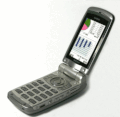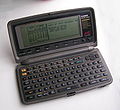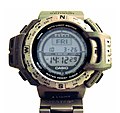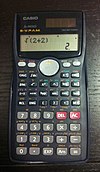Casio
 Casio's world headquarters in Shibuya, Tokyo | |
| Company type | Public |
|---|---|
| TYO: 6952 | |
| Industry | Electronic engineering |
| Founded | April 1946 (as Kashio Seisakujo)[1] June 1, 1957 (as Casio Computer Co., Ltd.) |
| Founders | Tadao Kashio, Toshio Kashio |
| Headquarters | Shibuya, Tokyo, Japan[2] |
Key people | Kazuo Kashio (Chairman and CEO) Kazuhiro Kashio (President and COO) |
| Products | Watches (includes G-Shock and Wave Ceptor ranges), Clocks, Calculators, Digital cameras, Electronic musical instruments, Label printers, Page printers, Office computers |
| Revenue | ¥338.4 billion (US$2.836 billion) (2015) |
Number of employees | 11,592 (2015) |
| Website | world.casio.com |
Casio Computer Co., Ltd. (カシオ計算機株式会社, Kashio Keisanki Kabushiki-gaisha) is a multinational electronics manufacturing company headquartered in Shibuya, Tokyo, Japan. Its products include calculators, mobile phones, cameras, musical instruments and watches. It was founded in 1946, and in 1957 released the world's first entirely electric compact calculator.
History
Casio was established in April 1946 by Tadao Kashio, an engineer specializing in fabrication technology. Kashio's first major product was the yubiwa pipe, a finger ring that would hold a cigarette, allowing the wearer to smoke the cigarette down to its nub while also leaving the wearer's hands free.[3] Japan was impoverished immediately following World War II, so cigarettes were valuable, and the invention was a success.
After seeing the electric calculators at the first Business Show in Ginza, Tokyo in 1949, Kashio and his younger brothers (Toshio, Kazuo and Yukio) used their profits from the yubiwa pipe to develop their own calculators. Most of the calculators at that time worked using gears and could be operated by hand using a crank or using a motor (see adding machine). Toshio, Tadao's brother, possessed some knowledge of electronics, and set out to make a calculator using solenoids. The desk-sized calculator was finished in 1954 and was Japan's first electro-mechanical calculator. One of the central and more important innovations of the calculator was its adoption of the 10-key number pad; at that time other calculators were using a "full keypad", which meant that each place in the number (1s, 10s, 100s, etc...) had nine keys. Another distinguishing innovation was the use of a single display window instead of the three display windows (one for each argument and one for the answer) used in other calculators.[1][4]
In 1957 Casio released the Model 14-A, sold for 485,000 yen,[5] the world's first all-electric compact calculator, which was based on relay technology. 1957 also marked the establishment of Casio Computer Co., Ltd.
In the 1980s, its budget electronic instruments and home musical keyboard instruments became popular. The company also became well known for the wide variety and innovation of its wristwatches. It was one of the earliest manufacturers of quartz watches, both digital and analog. It also began selling calculator watches during this time. It was one of the first manufacturers of watches that could display the time in many different time zones and of watches with temperature, atmospheric-pressure, altitude, and even Global Positioning System displays.
A number of notable digital cameras innovations have been made by Casio, including the QV-10, the first consumer digital camera with an LCD screen on the back[6] (developed by a team led by Hiroyuki Suetaka in 1995), the first consumer 3 megapixel camera, the first true ultra-compact model, and the first digital camera to incorporate ceramic lens technology.
Products
Casio's products include calculators, watches, cash registers, illuminators, digital cameras (Exilim series), film cameras, laptop and sub-notebook computers, mobile phones, electronic keyboards, PDAs (E-Data Bank), electronic dictionaries, digital diaries (early PDAs), electronic games, computer printers, clocks, and portable televisions.
In the 1970s and 80s, Casio was known for its electronic (including scientific) calculators and electronic musical instruments. Today, Casio is most commonly known for making durable and reliable digital watches.[6] The G-Shock range of shock resistant watches is popular, with the 1983 G-Shock DW-5600C being highly sought-after by collectors. Casio made a variety of digital watches with in-built games in the 1980s and 90s, which were highly popular at the time.
Casio also makes products for local markets, including a "Prayer Compass" watch designed to help Muslims pray on time and in the right direction.[7]
Calculators
Scientific calculators
Note: This is a list of selected calculators. Figures in parentheses imply approximate year of introduction.
- Graphing
- FX-9860G / GII / SD
- FX-9860G Slim
- ClassPad 300 Plus / 330
- Algebra FX 2.0 Plus
- FX 1.0 Plus
- CFX-9850GC Plus
- CFX-9850GB Plus
- CFX-9800G
- fx-9750G Plus / GII
- fx-8500G, 8000G
- fx-7500G, 7400G Plus / GII
- fx-7000G (ca. 1985)
- VI-9850GB Plus
- RM 7000/9000
- Programming
- fx-5800P, 3950P, fx-3650P, 50F Plus (2000s)
- fx-4500PA, 4500P
- fx-5500LA, 5500L
- fx-3900PV, 3900P (1990s)
- fx-4800P
- fx-3600P (1980s)
- fx-4000P, 3500P, 3800P, fx-5000F, 50F (late 1980s)
- FX-850P
- FX-702P (ca. 1981)
- FX-603P, FX-602P (1981)
- fx-180P, 390PV (Program) (early 1980s), fx-180PV,
- FX-502P, 501P (ca. 1979)
- Professional
- fx-FD10 Pro (2014) (Surveying calculator for civil engineering)
- CLASSWIZ (High-resolution Natural Textbook Display)
- fx-991EX, 570EX, 350EX, 82EX (early 2015)
- fx-JP900, JP700, JP500 (late 2014), (Japan only)
- "Natural V.P.A.M."
- "Natural Display"
- S-V.P.A.M. / Two-line, Multi-replay
- V.P.A.M. (Visually perfect algebraic method)
- LCD (One-line)
- fx-65 (True fraction) (mid 1990s)
- fx-95 (equation) (mid 1990s)
- fx-991D, 570D, 115D, 100D (early-mid 1990s)
- fx-82D, 250D, 82LB, 82SUPER, 82SX, 82SOLAR (early 1990s)
- fx-992V, 992VB, 991V, 115V, 85V; fx-991H, 911H (early 1990s)
- fx-991N, 911N, 115N, 85N; fx-250C, fx-570C (late 1980s)
- fx-991M, 115M, 85M; fx-451M,(mid-late 1980s)
- fx-650M; fx-580; fx-100C, 82C (mid-late 1980s)
- fx-570, 100, 350, 77 (early-mid 1980s)
- fx-82, 82B, 82L, fx-58 (early 1980s)
- fx-2000, 2200, 2500, fx-48(late 1970s)
- VFD (Digitron) display
- fx-1, 2, 3 (desk); fx-10 (handheld) (early-mid 1970s), used MSI (medium scale integration)
- fx-11, 15, 20, 101, 17, 19, 102, 1000, PRO fx-1, PRO-101, (mid-1970s)
- fx-21, 29, 31, 39, 120, 140 (mid-late 1970s)
- fx-201P, 202P (Program) (mid 1970s)
Basic calculators
Note: This is a list of selected models.
- LCD display
- Desk calculators
- DS-3TS, DH-160, DV-220, DJ-240D, DJ-120D, MJ-120D, MW-8V (2000s)
- Pocket calculators
- JS-140TVS, NJ-120D, SL-1000TW, HL-122TV (2000s)
- HL-810 (1985)
- SL-800 (FILM CARD) (1983)
- LC-78 (MINI-CARD) (1978)
- Printing calculators
- HR-100TM, DR-210TM (2000s)
- Desk calculators
- VFD (Digitron) / LED display
- Desktop calculators
- AL-1000 (1967)
- Pocket calculators (1970s)
- CM-601 (MINI)
- CM-606 (Personal MINI)
- 101-MR
- Y-811 (Memory-8R)
- AL-8 (with fraction input)
- H-813 (Personal M-1)
- CQ-1 (with clock function)
- Desktop calculators
Watches
- G-Shock
- Baby-G
- Oceanus
- Edifice
- Wave Ceptor
- Databank
- Pro-Trek
- Classic
Musical instruments
- Electronic Musical Instruments (Casiotone keyboards, Privia, Celviano, etc.)
- Keyboards
- Other instruments
- DG-20 electronic guitar (1987)
- Digital Pianos
- Privia (2005–present)
- Privia Pro Stage (2012–present)
- Celviano (2007–present)
- Celviano Hybrid/Grand Hybrid (2015)
- CDP Compact Series (2008–present)
Other
|
Digital cameras
PDA/DataBank
Electronic dictionary
Electronic games
Data and video projector
|
System products
Printing systems
Mobile Phones
Digital diaries (early PDA's: no longer produced) Game Consoles |
Gallery
-
Casio EV-SP3900 Electronic dictionary
-
Cassiopeia PDA
-
QV-10 Digital camera
-
EX-S600 Digital camera
-
Au W31CA Mobile phone
-
Casio fx-570MS
-
An old Casio calculator
-
Casio fx-115ES Scientific calculator with Natural Display
-
fx-991MS Scientific calculator
-
Casio fx-991EX ClassWiz (High-resolution Natural Textbook Display)
-
Casio fx-7000G, the world's first graphing calculator
-
FR-2650T calculator with printer for checkout
-
NAME LAND KL-P7
-
PB-770 pocket computer, with FA-11 extension dock
-
SF-R20 Digital Diary (early PDA)
-
F-105W watch (left) and fx-300ES scientific calculator (right)
-
Casio Sport OutGear SGW-400HD-1BV
-
Casio F-91W Digital watch
-
Casio Edifice EFA-111D-7AV watch with 10-year battery life
-
Casio PRG 60 AVER Triple Sensor Watch
-
Pro Trek Triple Sensor Watch
-
Casio "G-Shock" with "Tough Solar" watch
-
Casio Tough Solar "Wave Ceptor" watch
-
Casio "Wave Ceptor" Radio-Synchronized Watch
-
Casiotone 201
-
AZ-1 keytar
-
PG-380 MIDI Guitar
-
DH-800 Digital Horn
-
CTK-496 home keyboard
-
WK-200 workstation keyboard
-
Privia PX-130 digital piano
-
Casio Celviano AP-620
See also
- Casio graphic calculators
- Tandy Corporation for the Zoomer PDA
References
- ^ a b "History". Casio Computer Co., Ltd. Retrieved 30 April 2012.
- ^ "Corporate." Casio. Retrieved on February 25, 2009
- ^ "CASIO Corporate History 1954". CASIO-Europe. CASIO Europe GmbH. Retrieved 13 February 2016.
- ^ Tadao Kashio Biography: History of Casio Computer Company (2015). Astrum People website. Retrieved 11:04, Aug 26, 2015
- ^ Casio desktop calculator by Dentaku Museum.
- ^ a b Review: Casio:History
- ^ "PRAYER COMPASS". Retrieved 22 March 2015.
- ^ "Casio PT-80". Synthmuseum. Retrieved 7 September 2015.
- ^ "Full Review of the Casio PT-80 keyboard". Youtube. Retrieved 7 September 2015.
External links
- Casio Worldwide
- Casio International
- Casio Bangladesh
- Casio G-Shock Special Site
- Casio Edifice Special Site
- "Company history books (Shashi)". Shashi Interest Group. April 2016. Wiki collection of bibliographic works on Casio
- Casio
- Companies based in Tokyo
- Companies listed on the Tokyo Stock Exchange
- Electronics companies of Japan
- Electronic calculator companies
- Photography companies of Japan
- Defense companies of Japan
- Japanese brands
- Point of sale companies
- Synthesizer manufacturing companies
- Watchmaking conglomerates
- Watch brands
- Wearable computers
- Watch manufacturing companies of Japan
- Electronics companies
- Mobile phone manufacturers
- Companies established in 1957
- 1957 establishments in Japan
- Multinational companies headquartered in Japan
































